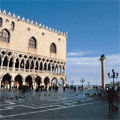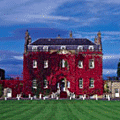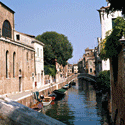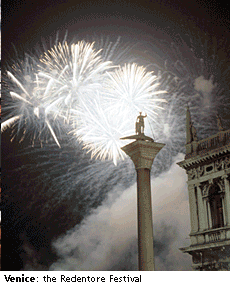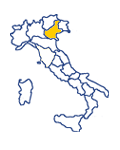Tuesday, 16 April 24 - 10:32 am
 |
|

 |
|
|
|
|

Venice Hotels

Reserve Venice Hotels: save up 70% on rooms!
Compare offers & book on line at hotel's web sites. |
|

|
|
Venice Guide Italy
Events
|
|
|
|
|
Events
Venice attracts visitors from all over the world thanks to its spectacular beauty and also thanks to the important international events that take place there, such as the Biennale and Film Festival. There is also the Venice Carnival, a period when it is difficult to find accommodation in Venice. It is therefore recommendable, if you are planning a trip to the city at the same time as one of these events, to book at least 1 or 2 months in advance in one of the Venice hotels or Venice bed and breakfast establishments that you have chosen.
- The Venice Carnival February - March
This is a wild, enjoyable festival. Carnival has ancient origins and originally lasted for a long time: from December 26th to Ash Wednesday.
In the past Carnival played an important social function: it created a temporary escape valve for the people who were strictly observed all year by the Doge’s government. In this period they at least appeared to be free, dressing up and partying day and night.
Shows were put on in the squares and in Piazza San Marco, especially on Jeudi and Mardi Gras, the most important days of Carneval. Carnevale reached the height of its magnificence in 1700 when it began to attract visitors from all over Europe. The “maschereri” were founded to meet the growing need for masks: they were true crafts experts for dressing up and created masks and heavy velvet cloaks for the occasion. The most fashionable mask was Bauta, a unisex costume made from a black tricorn hat, a white paper-mache mask that left the mouth uncovered for eating and drinking and a black cloak.
Carnevale is still celebrated in the open air today, with public shows and private parties organized in the Venetian palaces. People really let themselves go and there are many tourists around to watch, who either dress up or who just watch. The Venice Carnival has also invented some official sweetmeats: “fritole” (fried sweets) and “galani”. “Fritole” can be made with raisins and pine nuts (from Venice) or using a rich custard or zabaione filling.
- The Venice Biennale June - November
The first Venice Art Biennale took place in 1895, after the Palazzo dell’Esposizione was built in the Castello Gardens: The Italy Pavilion.
Works of art by great international painters such as Klimt and Renoir were shown at the Biennale in 1910 and the first national pavilions were prepared. These were due to multiply over the years, until they represented almost all the countries of the world.
In 1948 after the Second World War, the Biennale opened up again in grand style. It exhibited works by Chagall, Klee, Magritte and there was a retrospective exhibition of Picasso’s work presented by Guttuso.
In 1980 the Architecture sector was set up. This occupied the area of the Shipyard’s rope-making buildings. At a later point, the Art Biennale and the Architecture Biennale decided to alternate each year, each allowing the other to use all the space available for their exhibits, including the Pavilions in the Shipyard gardens.
- Festa del Redentore (The Redentore Festival)
the third Saturday and Sunday of July
This festival has its origins in a religious vow, just like the Madonna della Salute: During the first plague in 1576, the Doge promised to build a church dedicated to Christ the Saviour if the scourge that was destroying the city could be beaten.
The year after, on July 13th 1577, the plague finished, and the Senate decided to start up a city festival on the third Sunday of July each year. The Church of the Redentore (Savior) was built on the Giudecca island and a temporary bridge was built to it for the festival, to connect Zattere to Giudecca. This bridge has been assembled and dismantled every year since. However, the Redentore is not just a religious festival: whereas the Sunday is dedicated to a pilgrimage to the church and the mass celebrated by the Patriarch, the Saturday night is an event of a completely different kind. There is a fantastic fireworks display in the San Marco Bay. The fireworks are placed on rafts in the middle of the water and they light up the bay with a thousand colors. The Venetians wait for the fireworks on boats that are anchored in the middle of the bay and take food and drink with them. They wait until about 10 pm when the first explosions tell them the display is about to begin.
- The Venice Film Festival August - September
Each year the Venice Lido is lit up by lights from all over the world. For ten days it is the center of world social life.
The International Film Festival in Venice was set up in 1932, thanks to the encouragement given by the Count Volpi di Misurata, who was the Chairman of the Venice Biennale at the time. The Film Festival started up again in 1946, after a forced break during the Second World War. This was a period characterized by Neorealism, and masterpieces such as “Paisà” by Roberto Rossellini (1946) and “La terra trema” by Luchino Visconti (1948) were shown in Venice for the first time. Later editions of the Festival took on a more international connotation, first on a European scale and then including countries such as the United States, Japan and India in the competition. In the nineteen sixties the Festival became the launch pad for the English Free cinema and the French nouvelle vague, reinforcing even more the Festival’s international role.
The Festival continues to be an event that attracts a lot of visitors, both famous and non, amidst discussions and autograph hunters. They come from all over the world and provide the Venice Lido with a glossy, magical atmosphere.
- Regata Storica (The Historical Regatta) first Sunday of September
The historical Regatta is one of Venice’s most spectacular and charming traditional festivals.
The competition was started in the first half of the 13th century and has been much-awaited event for the Venetians for centuries. This is a parade of characteristic historical boats from the sixteenth century, with the crews dressed in period costumes and led by the Bucintoro, the characteristic boat that represents the Serenissima. After the parade there is a competition on the Grand Canal, which is watched by Venetian fans and enthusiastic tourists.
- Festa della Madonna della Salute (The Madonna della Salute Festival)
November 21st
On November 21st each year in Venice, the Madonna della Salute festival takes place which is memory of the liberation of Venice from the terrible plague that struck the city in the first half of the 17th century. This charming folk festival is centered around the Basilica della Salute, where church goers gather on a pilgrimage from all over the city, thanks to the temporary bridge that is built for the occasion with wooden rafts that cross the Grand Canal and which connect the area of San Moisé and Santa Maria del Giglio with the Basilica. On the day of the festival, tables are erected opposite the Basilica with all types of sweets on them and there are kiosks that sell candles to light in the church to pray for good health for relatives and friends.
Go to directories of the Web Sites
|
|
|
|
|
Acquista la tua visibilità su Travel Plan
|
|
|
|


